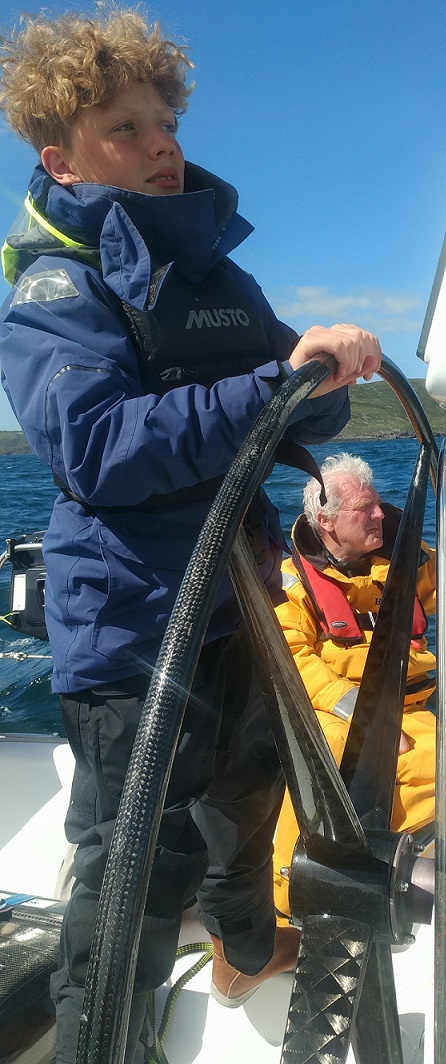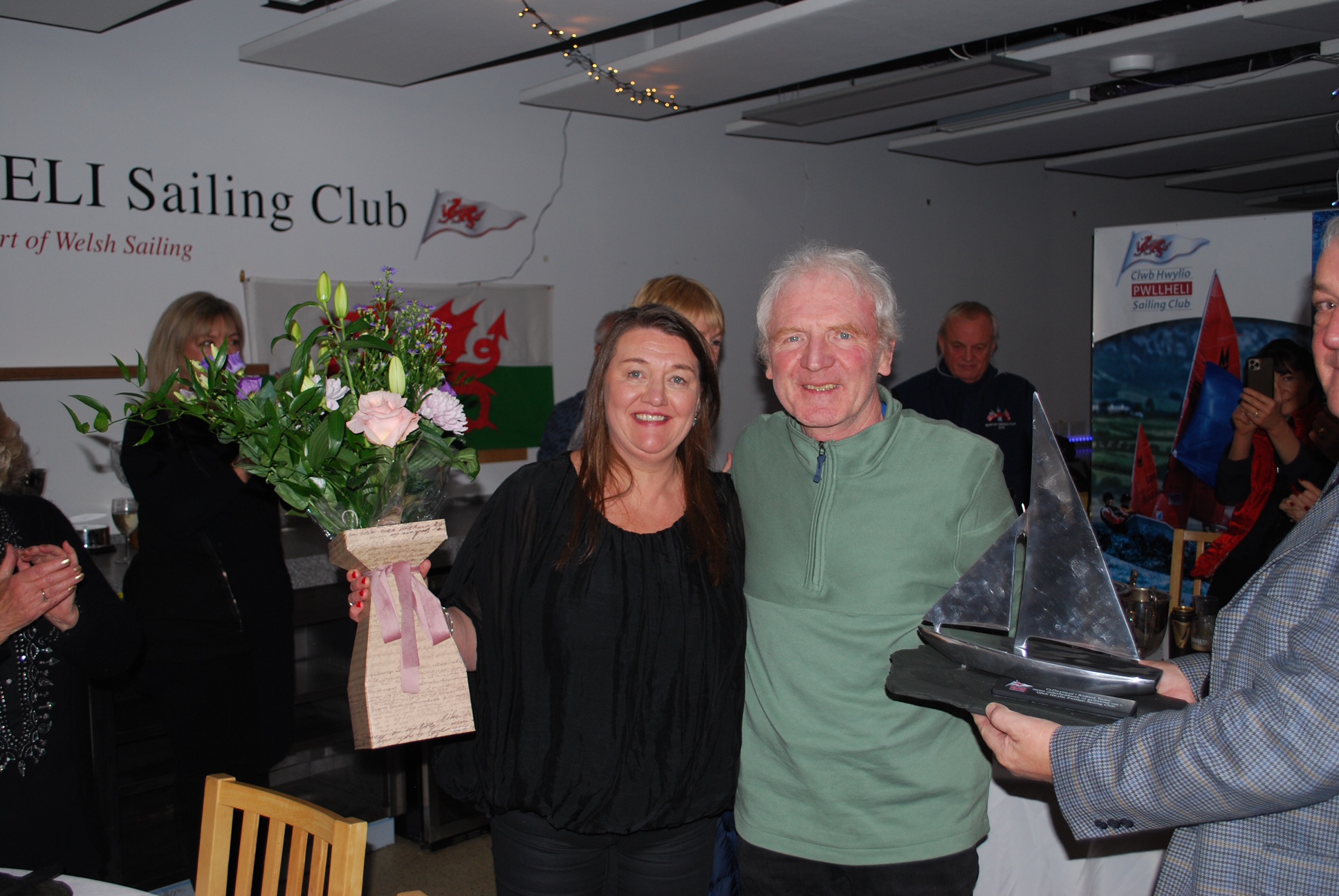Richard Tudor Lifetime Contribution Award 2021
Richard started sailing at a very early age and is one of Gwyndaf Hughes oldest sailing pupils, a relationship which we know they both cherish.
He built his first dinghy from kit in the living room at home. He competed in championships travelling from venue to venue with the red mirror dinghy, Madryn, on top of his mother’s Mini. No fancy campervans in those days.
He lost his mast on Llyn Tegid, Bala when the boom of a GP 14 crossed in front on port in front of Madryn in the School Championships. Gwyndaf managed to get permission to use the Bala School wood workshop to carry out temporary repairs (with jubilee clips) so that Madryn could proceed with the championship the following day.
Family boating started on Gay-anna with his father Huw, who is also a former Commodore, and with his brother. Keel boats started very soon after on a Halcyon 26, Reward, but Richard wanted to go faster so there was then Rev De Mer, then Gwobr Aur a Shamrock and then Panache a Contessa
Richard left school and took up an apprenticeship with North Sails and returned to Pwllheli to work for Brian Smart at ‘Sail Care’. Shortly afterwards Richard ventured and purchased the business. ‘Sail Care’ became ‘Tudor Sail Makers’. His white waterproofs were the height of sailing fashion, for a while, and his sailing kit bags are still seen and cherished by many. He designed and built some fancy spinnakers for winners such as Greased Lighting, Mererid, Megalopolis. He built several for Panache. A few of his sails are still in use today.
He sailed his first ISORA in 1976 with Anthony Jones and completed a Fastnet race in 1977 and 1981, and with many more to follow. One on Panache with an all Pwllheli Crew including Gwyndaf.
Richard’s dream, however, was on long distance offshore racing and he wanted to compete in the round the world Volvo race.
His dream came true when he was offered the Skipper role on British Steel, the Flagship for the ‘British Steele Round the World Challenge’, around the world the wrong way, against the prevailing winds and currents.
Things looked great, winning the first leg to Rio. A highlight of the stop-over was to meet Ronnie Biggs, the great train robber.
The second leg took the fleet past Cape Horn. Shortly after Cape Horn, and just before Christmas, the mast came down because of a fault in the forestay fitting on the stem head. The rest of the fleet was alerted to the fault and many boats were fitted with new masts at the next stop-over.
Now the story of his 3000 miles struggle to New Zealand/Australia is well documented. Fuel was replenished from a ship en-route. A stop in Chatham Islands where he was given a mast on condition that he dug it up from the ground in some scrub land. The much smaller mast was however lashed onto the remains of the boom that had been retrieved from the Ocean.
What is not known, however, is his heroism being in the water for hours on end, cutting the rigging that was endangering the boat itself. The crew of British Steel continue to meet every year, on the anniversary of the dismasting almost 30 years ago. School children across Wales learnt all about geography by following Richard’s track. These positions were radioed in, no gps and chart plotters then – he tells us.
The next big adventure for Richard was as skipper of Nuclear Electric, another circumnavigation as skipper. He was the toast of the town when Nuclear Electric was tied up to the pontoon on the marina. There were so many people wanting to see this fantastic vessel that the pontoon almost sank, and people had to be limited.
 Richard Skipper of Nuclear Electric
Richard Skipper of Nuclear Electric
These two circumnavigations were massive achievements for a young man.
Richard then led expeditions to the Artic Circle and to many other warmer and more exotic places.
He was also part of the Team Phillips experimental trimaran which sank in the North Atlantic and he and the crew were rescued by a passing ship, just as the boat fell apart and sank. He ended up in Halifax, Nova Scotia.
He competed in Regattas around the world, was part of the Corwynt Cymru Team winning Cork Week and Round Ireland.
He still holds the record for the best time ever on his Three Peaks race win in 1998 and was a winning skipper on the Round Britain and Ireland race.
Richard formerly opened the Pwllheli Marina in 1993, and the plaque is in the reception. He was a director of Porth Pwllheli, a consortium of local people wanting to develop Pwllheli into a world-renowned Marina, it is maintained to this day that this forced the hand of Dwyfor Council to develop what we now know as Hafan Pwllheli. Less known is the plaque above the raw sewerage filters; he performed the opening ceremony of the state-of-the-art sewerage works at the old club near the Gimblet
Then it was his time to stop living out of a sail bag.
He was asked to set up a new Marine College in Pwllheli – something he had campaigned for. He still works there as a lecturer today. His students learn the skills of Marine Engineering, and many have continued their connection with Richard from all around the world.
His anchor was now firmly ashore, and he met Falmai, the long suffering Falmai who does her best to get him home for supper. We are glad that Falmai and their daughter Leus often socialise with us in the Club.
Richard has been a member of the sailing club from the time of the very first building, we are now in our fifth home, he has seen all five club buildings as an active member.
Richard was Commodore in 2000 to 2002 and president in 2006 - 2008 and is still an active member of the club’s management committee.
Richard was instrumental in bringing the One Ton Cup to Pwllheli in 2001, the images of that event still resonate.
 Richard and Iago on JackknifeHe has worked tirelessly on the Academy project, which all started in 2003. He is an active board member of Plas Heli, a community enterprise, a role which is of course voluntary. He is involved with all aspects of Plas Heli’s development, but despite not being too well recently he will be found cleaning the floors, cutting the grass, repairing and maintaining the ageing ribs, preparing and arranging for events, inflating racing marks and ensuring we are all ready for these events, large and small. And setting the mood lighting in the bar!
Richard and Iago on JackknifeHe has worked tirelessly on the Academy project, which all started in 2003. He is an active board member of Plas Heli, a community enterprise, a role which is of course voluntary. He is involved with all aspects of Plas Heli’s development, but despite not being too well recently he will be found cleaning the floors, cutting the grass, repairing and maintaining the ageing ribs, preparing and arranging for events, inflating racing marks and ensuring we are all ready for these events, large and small. And setting the mood lighting in the bar!
In the bar we will often be treated to tales of adventure, he will often drop place names into a conversation such as Antigua, Palma and San Tropez, this is done not as a boast, and in the same way that we would talk about Abererch, Porthmadog and Sarn.
He is a qualified Race Officer and really enjoys the race management, he says it is a practical way of giving to others what he has enjoyed for so long. Only a few weeks ago he was the Officer of the Day for our club racing. He co-ordinated the setting up of our famous automated race starting system with the computer voice giving competitors a count-down to the start.
Richard has taken on the responsibility of ensuring that the racing marks are laid and retrieved every year and prepares the material for our annual calendar.
He still sails enjoys sailing and jumps at any opportunity to be on the water. He was a member of the Jackknife team on that fantastic race from Dun Laoghaire to Dingle where top speeds were achieved on the spinnaker run down to Tuskar, something that will stay with all of us forever.
What you get with Richard on the boat is great seamanship, he can spot a problem and fix it before it becomes a drama.
It is fantastic to see Iago and Richard sailing together. It is extraordinary to have three sets of father and sons, Andrew and Sam, Richard and Iago and Stephen and Thomas, all competing together on the same boat – truly memorable!
His contribution to our sailing and boating is phenomenal, what we take for granted would not be possible without the work that Richard does.
The following was received from Sir Chay Blyth
“Richard was skipper of British Steel 2 in the British Steel Challenge Round the World Yacht Race. He was one of only 12 skippers to be chosen from over 200 applicants all of whom had the same necessary Yacht Master qualifications to apply.
He was an inspirational leader, deeply respected and loved by his crew. They suffered one of the ultimate misfortunes in a Yacht race of losing their mast in the Southern Ocean at a point virtually the furthest from land of anywhere on the planet. In adversity the true mettle of people comes out. When the rigging needed cutting from the yacht it was Richard who went over the side with bolt cutters to free the debris from the yacht. Richard had the technical expertise to know what had to be done. He got the yacht and all his Crew back safely from the depths of the Southern Ocean safely to the Chatham Islands and then on to Wellington.
He never asked his crew to do anything that he wasn’t prepared to do, and hence the lasting respect that all his crew still have for him. They were highly competitive but also had great fun on the way, a tribute to the personality of their skipper who had the sailing talent to win the first leg of the Race, from Southampton to Rio.
A truly remarkable and outstanding sailor.”
Sir Chay Blyth
 Cymraeg
Cymraeg 

